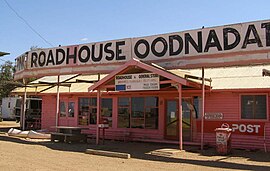Oodnadatta, South Australia
|
Oodnadatta South Australia |
|||||||||||||
|---|---|---|---|---|---|---|---|---|---|---|---|---|---|

The Pink Roadhouse at Oodnadatta
|
|||||||||||||
| Coordinates | 27°32′53″S 135°26′52″E / 27.54806°S 135.44778°ECoordinates: 27°32′53″S 135°26′52″E / 27.54806°S 135.44778°E | ||||||||||||
| Population | 166 (2011 census) | ||||||||||||
| Postcode(s) | 5734 | ||||||||||||
| Location |
|
||||||||||||
| LGA(s) | Outback Areas Community Development Trust | ||||||||||||
| State electorate(s) | Stuart | ||||||||||||
| Federal Division(s) | Grey | ||||||||||||
|
|||||||||||||
|
|||||||||||||
| Footnotes | Adjoining localities | ||||||||||||
Oodnadatta, in the Australian state of South Australia, is a small town surrounded by an area of 7,800 square kilometres (3,000 sq mi) with cattle stations in arid pastoral rangelands close to the Simpson Desert, 1,011 km (628 mi) north of Adelaide and 112 m above sea level. It can be reached by an unsealed road from Coober Pedy or via the unsealed Oodnadatta Track from Marree to Marla or from the north via Finke, Northern Territory ("Old Ghan Heritage Trail"). The name is derived from Arrernte utnadata, meaning "mulga blossom".
The population was 229 in 1976 and decreased to 160 in 1986. The 2006 census reported a population of 277 (150 male, 127 female, including 103 indigenous Australians).
John McDouall Stuart explored the region in 1859. The route mapped by Stuart in his journeys of 1857 to 1862 was adopted as part of the Overland Telegraph Line route. There was no township at Oodnadatta in those days. It was called the Yellow Waterhole, or Angle Pole, and later was known as Hookey's Waterhole.
By the 1880s this route was being used by camel trains, led by cameleers from Afghanistan, both of whom were especially brought to Australia for the task of hauling goods into Central Australia for use by pioneer settlers. Camels were the only pack animals capable of taking on a six-week journey in often extreme heat, through sandy terrain. When train travel arrived, many of these camels were left to run wild in the outback where they number in the tens of thousands today. Many Afghan men and their families eventually settled in Oodnadatta and Maree, some marrying into the Aboriginal community.
...
Wikipedia

